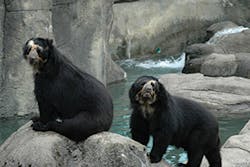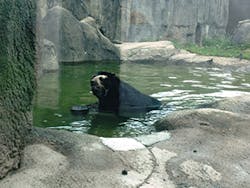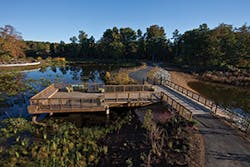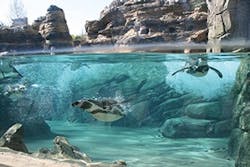Increasingly, zoos in America are using green infrastructure to manage their stormwater, and they’re doing so in a variety of creative and innovative ways. This practice shouldn’t be surprising, given the mission of zoos and their natural interest in safeguarding the environment.
“We have a duty and an opportunity to take these things and educate people about them, so we have signs at our exhibits that ask ‘Where’s the water come from?’ and ‘What’s under your feet?'” says Mark Fisher, P.E, director of facilities and planning at the Cincinnati Zoo and Botanical Garden.
He adds, “Our education people talk about stormwater while they talk to visitors about the animals.”
“School groups come [to the Rosamond Gifford Zoo] to see green infrastructure, not just the animals,” says Joanne Mahoney, Onondaga County (NY) Executive.
“When zoos were created, they were for exhibiting animals. Now they are so much more about conservation. Conserving water and energy is a natural extension of zoos’ conservation of animal species,” says Emily Dawson, AIA, an associate with SRG Partnership Inc. and designer of the Elephant Lands exhibit at the Oregon Zoo in Portland.
One of the reasons that zoo officials see value in capturing stormwater and cleaning it through green infrastructure for use within the zoos is that their need for water is unrelenting. Landscaping has to be irrigated. Visitor areas and animal exhibits must be kept clean, and hosing them down is quick.
Even if a zoo doesn’t have marine animals, plenty of species require ponds to swim and play in. In the past these pools, especially those for birds, had to be emptied, scrubbed, and refilled with tap water. That’s costly in terms of both labor and water. It adds to the volume of wastewater flowing into the city sewers and increases stormwater utility fees. Green infrastructure has cut these costs.
“Our water usage is down 80% from eight years ago,” says Fisher.
The North Carolina Zoological Park in Asheboro has wetlands adjoining its manmade North America Lake (10 acres) and Africa Lake (12 acres). Two 20-horsepower pumps operate at Africa Lake because the water has to be pumped up 100 feet. North America Lake has one 15-horsepower pump.
“The irrigation pumps are generally running 24/7,” says Gerry Parker, P.E., the zoo’s director of facilities. The cleaned and reused water “keeps moats like those at the lemurs’ and elephants’ exhibits topped off.”
Parker adds, “There’s an artificial stream in the giraffes’ area. The pumped irrigation water keeps it running. We save a tremendous amount of water.”
Fisher says that managing stormwater at a zoo has some unique challenges compared to managing it elsewhere. “First of all, we have a very diverse set of surfaces—roof asphalt, parking lots, walkways, and areas with different chemicals that we use for disinfecting. They get in the runoff.”
The spread of a zoonotic disease (one that can be spread from one species to a different one) is a constant concern. “For example, rain falls on the giraffe yard and goes into the tank, and then we send it to the polar bears’ area,” he says. “How do we filter it to keep the water safe for the polar bears?”
Fisher adds, “Our biggest challenge in general with stormwater and our open systems is dealing with dirt, mulch—that heavy stuff. It wreaks havoc on our filters. We’ve had to add prefilters in front of the prefilters. We’re getting better at keeping heavy debris out of the system, but it’s a constant effort.”
Some of the stormwater management at the Cincinnati Zoo and Botanical Garden is in the hands—er, paws—of the cheetahs. More accurately, it’s under their paws. And also under the hooves of the gazelles.
That’s because the cheetahs’ landscape and adjacent ones for other African animals comprise the Cincinnati Zoo’s $32 million African Savannah exhibit. The land is a 20-acre watershed within the zoo’s campus.
Only a few years ago, the space was a large impervious parking lot that sent millions of gallons of untreated runoff into Cincinnati’s overloaded combined sewer system. Now, thanks to some amazing design and engineering work and wise deployment of green infrastructure, the site infiltrates about one-third of the zoo’s stormwater, 15 million gallons annually.
“The African exhibit has validation for me that there are relatively common-sense solutions to these huge problems [of stormwater management in large areas]. It’s rewarding and validating to know that these are simple solutions, homegrown engineering, and they work,” says Fisher.
The central part of managing stormwater in the African Savannah exhibit is a 55,000-gallon storage tank with liner by StormTech. Positioned beneath the areas for the African painted dogs and the gazelles and other hoofed mammals, the tank receives runoff from the entire exhibit.
“It’s 15 feet deep and the size of an NFL football field,” says Fisher.
Managing stormwater in this section of the zoo was made challenging because it has “serious groundwater issues,” explains Fisher. “Water levels are inconsistent. Dig in one spot, and it’s like a waterfall. Go 20 feet away, and there’s no water.”
The other major challenge with the African Savannah exhibit was that “nobody has done anything like this in the US. There were no manuals, no examples, no white papers to follow,” says Fisher.
Because the exhibit is a 20-acre watershed, there are many interconnections within it. One example is the giraffe yard’s moats, which collection stormwater and send it through French drains into the lions’ exhibit area.
The zoo’s new parking lot across Vine Street has more than 40,000 square feet of pervious concrete paving. Because of the area’s expansive clay soil, the parking lot was designed to have its own detention system.
The pervious concrete was designed with 15 to 21 inches of #2 washed, recycled concrete as a base. Recycled 304s were added to the top 2 inches. Under the gravel is a woven filter fabric with drain pipes running parallel to the length of the parking stalls and perpendicular to the main at approximately every 40 feet.
The catch basins were set at elevations to allow runoff to enter the storm sewer, but only if the entire system was overloaded. The work was done by McD Concrete of Alexandria, KY.
Other examples of green infrastructure at the Cincinnati Zoo include three green roofs. They are over the Primate Center (about 2,000 square feet), the African painted dog exhibit (about 1,000 square feet), and the Giraffe Ridge Barn (2,400 square feet).
“Our rain gardens are concentrated at the education center, parking lot, and escalator and elevator building. At four of our buildings all of the rain that falls on the roofs goes into rain gardens,” says Fisher.
Historic Village, the entry point for the zoo, has about 30,000 square feet of pervious pavers. They were supplied by Reading Rock, a Cincinnati company.
Cincinnati’s Metropolitan Sewer District (MSD) works closely with the zoo. Fisher says that because the zoo “has been here for 130 years, people have confidence is us. They know we’ll maintain the [new or innovative] system. Unlike a developer who may be gone in five years, we’re not going away.”
That stability means that sometimes it’s easier for the zoo to secure approval or variances from MSD or other regulatory agencies for projects. “We’re a 60-acre pilot for all of these sustainable strategies,” he adds.
The first part of the African Savannah exhibit was completed in April 2009. The cheetahs’ section opened in 2013, and more areas will be developed.
Kahless, a spectacled bear, swimming in the stormwater cistern pool at the Rosamond Gifford Zoo in Syracuse, NY
Rosamond Griffin Zoo
Like other parts of Onondaga County, the Rosamond Griffin Zoo in Syracuse, NY, is managing stormwater through green infrastructure projects, all part of the Save the Rain program. Save the Rain was founded by Onondaga County Executive Mahoney.
When Mahoney was elected, Syracuse and its Onondaga County suburbs were under a consent decree from EPA. Part of that decree involved the construction of four wastewater treatment plants in suburban neighborhoods. Citizens were very unhappy.
One treatment plant had been built, but Mahoney worked with other community leaders and federal officials to gain first a delay in constructing the additional three plants, and then the right to substitute green infrastructure projects that would keep stormwater out of the sewer system. Those projects would be part of a new program, Save the Rain.
Mahoney says that people began to realize “This is an alternative to sewage treatment plants that are expensive to build and massive energy consumers. They’re engineering solutions [to stormwater management problems] that look like beautiful landscaping”
As these Save the Rain projects at the zoo and elsewhere in Onondaga County have proven to be successful, the public’s attitude “is now the opposite of ‘not in my backyard.’ People want us to do green infrastructure projects in their neighborhoods.”
She notes, “People have embraced the idea of treating water differently than was done in the past. They understand more than people who have not had to endure a combined sewer system and overflows.”
Now, she says, “For every public works project we do in Onondaga County, we try to figure out how we can use green infrastructure.”
One Save the Rain project at the zoo is a stormwater cistern that is part of the bear exhibit. The cistern receives stormwater from the exhibit itself, as well as from adjacent pathways.
The water in the cistern is pumped through a UV system, then into the exhibit in a newly constructed streambed between two existing ponds. The stormwater flows continuously within the recirculation route, providing the bears plenty of clean water to swim and splash in.
Another Save the Rain project at Rosamond Gifford Zoo includes a wetland adjacent to the penguin exhibit. An open streambed allows runoff to flow from the wetland into the swan and duck ponds.
Once the flow reaches the duck pond, it returns to the stormwater wetland via a pumping system. This recirculation system allows for a greatly reduced use of potable water at the zoo while simplifying and reducing the frequency of maintenance within the duck pond.
Other green stormwater projects include the rain gardens at the primate exhibit. A green roof over the larger elephant barns (6,000 square feet, completed in May 2011) handles 114,000 gallons of stormwater each year.
The zoo’s main parking lot has 29,500 square feet of porous pavement and Silva Cell tree trenches. The courtyard has 2,500 square feet of Flexi-Pave porous pavement. At the front entrance there are 2,655 square feet of Addaset porous pavement.
Rain gardens are adjacent to Conservation Place and Wilbur Avenue at the zoo’s entrance. Already existing catch basins were connected and now divert the captured runoff to three nearby wetlands. Maloney says students from area schools study the wetlands and do water-quality testing. The land belonged to the Onondaga County and had been a natural wetland.
These green infrastructure projects keep about six million gallons of runoff out of the sewer system annually. Onondaga County’s Save the Rain program has received a lot of attention from stormwater officials in other cities. Mahoney says, “We put everything on our website, and we encourage people everywhere to steal our ideas.” (See www.savetherain.us.)
Oregon Zoo
At the Oregon Zoo in Portland, a new exhibit called Elephant Lands is drawing the lion’s share of attention. This exhibit, which combines innovative stormwater management with an improved living space for the zoo’s herd of elephants, will be completely finished late this year.
Elephant Lands covers 6 acres and has a total cost of $57 million. It is the first project in the 20-year master plan that the Portland architecture firm SRG Partnership created for the zoo in 2010.
Lead architect Dawson says, “It was an advantage to have the zoo ask [first] for a master plan. We could look at the whole campus and plan how to interact with the rest of the campus for stormwater, energy, and potable water.”
She notes, “Stormwater management is the unsung story about the project. It’s all underground, so people don’t see it. It’s such a big deal, because we get so much rain here.”
Green infrastructure used to manage stormwater here has three phases. The heaviest rains fall in winter, when attendance is lowest and not as much space is needed. Regrading of hard surfaces will allow temporary puddling that visiting children in their boots may want to splash in.
“We celebrate rain here!” says Dawson.
Beyond temporary puddling that allows stormwater to evaporate are bioswales following the zoo’s main path and around the concert lawn by the South Habitat of the elephants’ area. The final phase, for heaviest runoff, is a 70,000-gallon tank buried beneath the South Habitat.
“Elephant Lands will mitigate half of the stormwater that falls on the zoo,” says Dawson. “The life support system for the elephants is a really sophisticated filtration system. It will save 80% of the water that is needed and reuse it, instead of always pumping fresh water and dumping it later.”
The project’s main challenge is that “the entire zoo is in a landslide zone. Soil is so saturated that we had to do a lot of retaining. We set finger drains that go back into the hills. The weight of the sand (three to five feet deep) was mitigated by underlying French drains,” she explains.
Paul Dedyo, associate/project manager at KPFF Consulting Engineers, says that these 300-foot-long finger drains were needed “for seismic stability. We arrayed 16 of them in a fan shape. That brings the groundwater down, improving the stability of the hill above.”
Components of the drainage system at Elephant Lands came from Advanced Drainage Systems (ADS).
Dedyo says that Elephant Lands has been a challenging project because “it’s phased construction. Maintaining access and safety for people and animals was essential at all times. You can’t just cut a line and build new, because you have to have continuous service for the animals.”
He adds that working at the edges of the project, where it comes up against existing utility lines and other zoo facilities, is tricky.
Dawson says that, despite the phased work, the elephants never had less space than they did before construction on their exhibit began.
“In anticipation of a future wastewater treatment plant onsite, purple pipe water reuse lines were installed for nonpotable water needs,” says Dedyo. “Parts will be done with each of the [future exhibit] bond projects.”
Other installations that will help the Oregon Zoo save money and manage its stormwater better include a new water distribution system. Outdated pipes are being replaced. At the north end of the parking lot is a building that contains a pressure-reducing backflow prevention assembly. This device keeps harvested rainwater from mixing with city tap water.
Besides Elephants Lands, rainwater harvesting happens at the Veterinary Medical Center’s 17,500-square-foot main roof. Rain flows to a 30,000-gallon water silo. The new Education Center will also have rainwater harvesting capability.
The Oregon Zoo has green roofs at the Elephant Lands (2,500 square feet) and Condors of the Columbia (900 square feet) exhibits. Construction will begin this fall on the Education Center, which will have a 3,000-square-foot green roof.
Dragonfly Pointe constructed wetlands at the North Carolina Zoological Park
North Carolina Zoological Park
The North Carolina Zoological Park has a 1.2-acre constructed wetland, a BMP retrofit. It treats runoff from the zoo’s 11-acre parking area and is located on a section of the manmade North America Lake.
Called Dragonfly Pointe, the wetland is an attractive exhibit that draws many of the zoo’s visitors. Its adjacent signage educates them about the workings and benefits of a wetland.
The deck of the exhibit extends out above the wetland, allowing close observation of plants and wildlife. The deck also serves as a picnic area. The cost of the project was $1 million.
The project involved constructing a dam with a unique triple barrel outlet. Dan Robinson, P.E., and other members of Kimley-Horn and Associates’ (KHA’s) engineering team in Raleigh, NC, created this device to regulate the water level in the wetland and provide water-quality treatment.
“We designed it from scratch—our structural design folks and our water resource team. We talked it over with NCDOT [North Carolina Department of Transportation]. They paid for a portion of the design because the zoo is owned by the state,” explains Robinson.
“Some of the orifices allow water to flow back and forth. Some have check valves so water can’t enter from that drain,” he says. That might have been overkill, but with a wetland you always run the risk of the plants not doing well.”
If a drought occurs, the triple barrel outlet allows backflow from the adjacent North American Lake. The wetland is designed to handle a 100-year storm event.
Planning for the project included testing for runoff contaminants and the actual design of the constructed wetland, including selecting plants, devising educational features explaining wetland benefits, building the picnic deck, and tying the wetlands to a nearby picnic area and trails.
Students from Asheboro High Zoo School assisted with the plant list and provided estimates of the cost of the plants. They continue to perform water-quality monitoring for the project.
The Clean Water Management Trust Fund (CWMTF) approved $406,000 for the project in July 2006. NCDOT agreed to provide the design funds and contracted with KHA to produce the construction documents.
Because construction costs had increased, the zoo applied for and received an additional $217,000 in CWMTF funding. Construction was completed in May 2009.
The zoo’s horticulture staff installed native North Carolina plants shortly afterward. Shrubs included sweet pepperbush and wax myrtle. Aquatic plants—besides the appropriately chosen duck potato and lizard tail—include soft rush, sweet flag, blue flag iris, hop sedge, and wool grass.
Robinson says that one challenge of the project, “unusual for a wetland, was that the geese population was an issue. They would eat the native wetland plants, so we put up various features to distract them from settling there.”
Adding curved walls and dense vegetation along the banks would make it harder for the geese to see predators, so they would naturally avoid those areas. Gates were installed to keep the geese from walking down the exhibit’s handicap ramp.
Parker says that the lake and wetland system has worked well for the zoo. “The lakes do attenuate the stormwater. Most of our watersheds within the zoo travel to a lake.”
He says, “We’ll probably add a lake or two in the future, as we expand, and we’ll incorporate post-construction stormwater controls in everything we do.”
Humboldt penguins swim in a stormwater-filled pool at Seattle’s Woodland Park Zoo.
Woodland Park Zoo
The Woodland Park Zoo in Seattle has an indoor learning center to teach children ages two to eight about the environment of the Pacific Northwest. Called the Zoomazium, it was designed by Deb Guenther, principal with Mithun, a Seattle landscape architecture firm.
An essential part of the Zoomazium is its 8,500-square-foot green roof, which was designed to look like the floor of a Pacific Northwest forest. Native plants on this roof include sword fern, salal, beach strawberry, and blue-eyed grass.
Two new exhibits are making a real splash at the Woodland Park Zoo and helping with stormwater management. Both exhibits were designed by Becca Hanson, FASLA, of Studio Hanson/Roberts in Bainbridge Island, WA, a firm that specializes in zoo projects.
The $6.5 million Humboldt penguin exhibit opened in 2009. It emulates the desert coast of Peru, where Humboldt penguins live, and measures 17,000 square feet.
Hanson says the project’s biggest challenge was “creating a setting for the treatment wetlands that could be appreciated by the general public without distracting from the ‘desert’ theme” of the exhibit.
Instead of traditional fill and dump practices, the penguins’ 32,000-gallon pool was filled only once. Stormwater collected from the roof is stored in belowground tank to use for refilling the pool as needed.
The pool is heated and cooled by geothermal wells. The backwash is filtered through a constructed wetland. This innovative design saves 3 million gallons of water and 22,000 kWh of energy each year.
What pleases Hanson most about the exhibit is “the way that the penguins are able to make use of all parts of their exhibit and the fact that the water temperatures and water quality came out exactly as we had planned.”
She adds, “Monica Lake, the zoo’s project manager and director of capital projects, was able to get Seattle Public Utilities and the zoo staff excited about participating in the project.”
The Banyan Wilds exhibit, which features Asian animals including small clawed otters and tigers, opened in May of this year. For stormwater management it has pervious pavement throughout and rain gardens. The roofs drain to the rain gardens.
Hanson says the most difficult part of creating Banyan Wilds was “squeezing the project onto a very tight site without losing our ability to maximize our green footprint.”
Her favorite part of the exhibit? “The way the tigers have taken to the water in their habitat!”
Hanson agrees that there is a growing trend for zoos to combine stormwater management and water supply. “We do a lot of work in Australia and New Zealand, both of which are very cognizant about their water resources,” she notes.
These zoos and numerous others across America have realized that treating stormwater as a resource instead of as a liability helps them save money on their water bills. Incorporating green infrastructure into their exhibits educates zoo visitors young and old, and helps the long-term mission of protecting animals and their environments.





